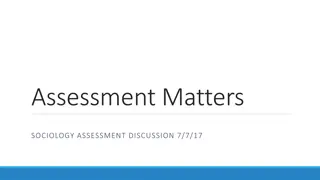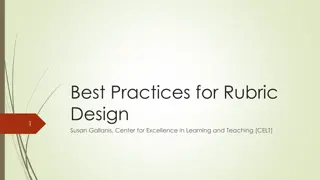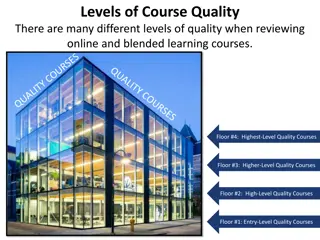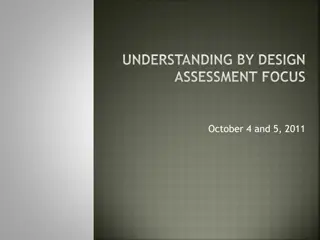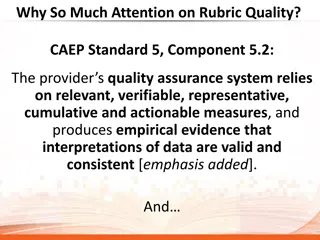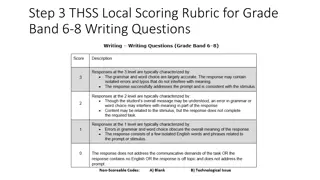Mastering Rubric Design for Effective Assessment
Rubrics are essential tools in evaluating and providing feedback on student performance. This comprehensive guide covers the definition, elements, and benefits of rubrics, along with expert tips on designing impactful rubrics for various assessments. Explore the art of rubric design, learn what makes up a rubric, and understand why using rubrics enhances the assessment process.
Download Presentation

Please find below an Image/Link to download the presentation.
The content on the website is provided AS IS for your information and personal use only. It may not be sold, licensed, or shared on other websites without obtaining consent from the author.If you encounter any issues during the download, it is possible that the publisher has removed the file from their server.
You are allowed to download the files provided on this website for personal or commercial use, subject to the condition that they are used lawfully. All files are the property of their respective owners.
The content on the website is provided AS IS for your information and personal use only. It may not be sold, licensed, or shared on other websites without obtaining consent from the author.
E N D
Presentation Transcript
RUBRIC RUBRIC DESIGN DESIGN Dr. Rob Danin Dr. Rob Danin English Language Specialist English Language Specialist www.robdanin.com www.robdanin.com
WHAT IS A RUBRIC? An authentic method of assessing the learner Provides a transparent assessment process A guideline for rating student performance (Asmus, 1999). Defines the range (continuum) of possible performance levels. An evaluative tool that assesses specific areas of instruction Clear and relevant Age appropriate (student-friendly)
ART OF RUBRIC DESIGN ART OF RUBRIC DESIGN Experts agree: Rubrics are hard to design Rubrics are time-consuming to design A rubric is only as useful as it is good. Using a bad rubric is a waste of time --Michael Simkins in Designing Great Rubrics
WHAT MAKES UP A RUBRIC? criteria and scale among the descriptors (these two elements usually go together) Rubrics include descriptors descriptors for each targeted category The core of the rubric Each level of performance should have descriptors which clearly indicate what is necessary to achieve that level of performance. Example Example Exceeds Expectation (4-points): Work is clearly organized and includes a diagram or step-by-step analysis. Rubrics provide a criteria scale which differentiates category descriptor descriptor scale scale criteria criteria
THE THE RUBRIC: A COOKIE! RUBRIC: A COOKIE! Delicious 4 Tasty 3 Edible 2 Not yet edible 1 Criteria Criteria Scale Scale 75% chips 50% chips Less than 50% chips Category Category # chips Descriptor Descriptor Chips in every bite Consistently chewy Chewy middle, crispy edges Crunchy Like a dog biscuit texture Even golden brown Brown with pale center All brown Or all pale Burned color Buttery, high fat Medium fat Low-fat flavor Nonfat flavor richness
WHY A RUBRIC? WHY A RUBRIC? The purpose of using rubrics is to provide a more systematic way of describing/evaluating a performance that is more qualitative quantitative quantitative in nature. (Greer and Kale, n.d.) To clearly show clearly show students how their work is being evaluated To communicate communicate detailed explanations of what constitutes excellence To serve as a means for clarifying assignments and experiences Usually with a relatively complex assignment relatively complex assignment, such as a long-term project, essay or research-based product qualitative than clarifying expectations for
BENEFITS OF A RUBRIC BENEFITS OF A RUBRIC Improve student performance Encourage students to check progress using a rubric (formative assessment) Allow for multiple correct answers Encourage / require self-assessment and/or peer assessment (formative assessment) Detailed evaluations of final projects (summative assessment) Provide those who have been assessed with clear information about how well they performed Provide those who have been assessed with a clear indication of what they need to accomplish in the future to better their performance
HOW TO USE A RUBRIC HOW TO USE A RUBRIC Expect to revise and revise Adjust the rubric after, not during the assessment Make changes soon after grading Keep track of strengths and weaknesses of rubric as you use it to assess student work Were the criteria, scale and descriptors easy to follow? Did the overall grade reflect performance? When you ve got a good one, SHARE IT! Share rubrics with students at the start of the project - criteria helps students understand teacher expectations Model proper rubric usage when and how Provide examples (models) of student work showing varied performance levels for learners
RUBRIC DESIGN: GETTING STARTED RUBRIC DESIGN: GETTING STARTED If you use generic or online rubrics make sure to carefully consider their quality to see if this rubric is appropriate for your project If you use a previously developed rubric: If you use a previously developed rubric: Find a rubric that most closely matches your performance task Evaluate and adjust to reflect your instruction, language, expectations, content, students Criteria Scale Descriptors If you make your own rubric: An easy way is to set up tables in Word (the number of columns will depend upon how many levels of proficiency [criteria/scale] you want to show
RUBRIC DESIGN: RUBRIC DESIGN: CRITERIA & SCALE CRITERIA & SCALE NUTS & BOLTS NUTS & BOLTS Aim for an even number of levels Create a continuum between least and most Define extremes and work inward Describe proficient levels of quality No evidence, minimal evidence, partial evidence, complete evidence Emerging, developing, achieving Below average, average, excellent Unacceptable, acceptable, competent, proficient
THE THE RUBRIC: A COOKIE! RUBRIC: A COOKIE! Delicious 4 Tasty 3 Edible 2 Not yet edible 1 Criteria Criteria Scale Scale 75% chips 50% chips Less than 50% chips Category Category # chips Descriptor Descriptor Chips in every bite Consistently chewy Chewy middle, crispy edges Crunchy Like a dog biscuit texture Even golden brown Brown with pale center All brown Or all pale Burned color Buttery, high fat Medium fat Low-fat flavor Nonfat flavor richness
RUBRIC DESIGN: RUBRIC DESIGN: DESCRIPTOR DESCRIPTOR NUTS & BOLTS NUTS & BOLTS Know the specific skills or knowledge you want to measure Align the assignment with the rubric. Use same language. Aim for concise, clear, jargon-free language Avoid wordiness, and negativity Limit the number of descriptors Separate key descriptors Use realistic, teachable descriptors
RUBRIC DESIGN: RUBRIC DESIGN: DESCRIPTOR DESCRIPTOR NUTS & BOLTS NUTS & BOLTS Use concrete versus abstract and positives rather than negatives List skills and traits consistently across levels Use measurable/observable (identifiable) descriptors Someone else should be able to use your rubric and score your assignments as you would Reliable and Valid Leave space for specific comments during grading Match written comments to phrases in rubric Include all non-negotiable items On time Formatted correctly Follows standard conventions Etc.
THE THE RUBRIC: A COOKIE! RUBRIC: A COOKIE! Delicious 4 Tasty 3 Edible 2 Not yet edible 1 Criteria Criteria Scale Scale 75% chips 50% chips Less than 50% chips Category Category # chips Descriptor Descriptor Chips in every bite Consistently chewy Chewy middle, crispy edges Crunchy Like a dog biscuit texture Even golden brown Brown with pale center All brown Or all pale Burned color Buttery, high fat Medium fat Low-fat flavor Nonfat flavor richness
CAUTION: COMMON RUBRIC PITFALLS Rubric does not correspond with class or program outcomes Scale does not have enough levels Too broad, not enough content described Too long/too complicated
REVIEW: RUBRIC DESIGN REVIEW: RUBRIC DESIGN Define extremes and work inward Deliberate sequence of criteria Must be clear to students upfront High reliability and validity Provide varied samples of student work Pilot with students adjust accordingly Clear, observable and essential criteria Realistic number of criteria Explicit, observable indicators Align the assignment with the rubric Include all non-negotiable items An even number of standards of excellence Create a continuum between least and most
NEXT STEPS: NEXT STEPS: MINI MINI- -RUBRIC RUBRIC Rubrics that are quick to use Fewer criteria and shorter descriptions of quality Yes/no checklists Describe proficient level of quality and leave other boxes for commentary during grading Use for small products or processes Poster Outline Journal entry Class activity
SAMPLE: SAMPLE: MINI MINI- -RUBRIC RUBRIC Vocabulary Poster Purpose: to inform Content criterion (50%) 4 Content criterion (50%) 4 ____written explanation of denotation accuracy/thoroughness ____examples in action accuracy/variety ____visual symbol or cartoon conveys word meaning-- accuracy/clarity ____wordplay---weighs synonyms for subtleties of meaning-- accuracy/thoroughness Presentation criterion (50%) Presentation criterion (50%) 4,3,2,1--neat 4,3,2,1--clear organizational pattern 4,3,2,1--no error in Conventions 4,3,2,1--uses visual space to catch and hold attention Score= Content___ + Presentation___ = ______GRADE Comments: Comments: 3 3 2 2 1 1
NEXT STEPS: NEXT STEPS: STUDENT CREATED RUBRICS STUDENT CREATED RUBRICS Include students in creating or adapting rubrics This form of self-assessment helps with providing the learner a greater understanding and appreciation of what they are being evaluated on. Consider using I in the descriptors I I followed I I did not follow
SAMPLE: SAMPLE: STUDENT STUDENT- -FRIENDLY RUBRIC FRIENDLY RUBRIC
SAMPLE: SAMPLE: STUDENT SELF STUDENT SELF- -ASSESSMENT RUBRIC ASSESSMENT RUBRIC
SAMPLE: SAMPLE: PEER ASSESSMENT RUBRIC PEER ASSESSMENT RUBRIC
OTHER RUBRIC SAMPLES: OTHER RUBRIC SAMPLES: ORAL PRESENTATIONS ORAL PRESENTATIONS
OTHER RUBRIC SAMPLES: OTHER RUBRIC SAMPLES: POWERPOINT PRESENTATIONS POWERPOINT PRESENTATIONS
RUBRIC DESIGN ACTIVITY RUBRIC DESIGN ACTIVITY Develop a new or revise an existing rubric (using the rubric template provided to you) that can be used with your students in a particular content area. When creating this rubric, please take into consideration those elements of effective rubric design that were discussed (please see rubric review sheet from this presentation). Feel free to evaluate your rubric using the Rubric Design Rubric provided to you. If there is time and the desire, feel free to break into small groups to constructively critique the rubrics you have created.
RUBRIC DESIGN RUBRIC RUBRIC DESIGN RUBRIC
RUBRIC DESIGN RUBRIC RUBRIC DESIGN RUBRIC _______/15 Points _______/15 Points
RUBRIC TEMPLATE RUBRIC TEMPLATE
RUBRICS ON LINE RUBRICS ON LINE http://rubistar.4teachers.org/ http://rubistar.4teachers.org ://rubistar.4teachers.org/ / (create your own) http (create your own) http://www.teach-nology.com/web_tools/rubrics/ http://www.teach ://www.teach- -nology.com/web_tools/rubrics nology.com/web_tools/rubrics/ / http http://www.rubrician.com/language.htm http://www.rubrician.com/language.htm http://www.rubrician.com/language.htm http://www.rubrics4teachers.com/ http://www.rubrics4teachers.com/ http://www.rubrics4teachers.com/ http://www.rubrics4teachers.com/powerpoint.php http://www.rubrics4teachers.com/powerpoint.php (PPT rubrics) http://www.rubrics4teachers.com/powerpoint.php (PPT rubrics) http://www.nadasisland.com/rubrics.html http://www.nadasisland.com/rubrics.html (EFL/ESL) http://www.nadasisland.com/rubrics.html (EFL/ESL) http://www.rcampus.com/rubricshowc.cfm?code=L24W4Asp=yes http://www.rcampus.com/rubricshowc.cfm?code=L24W4A&sp=yes (EFL speaking) http://www.rcampus.com/rubricshowc.cfm?code=L24W4A&sp=yes (EFL speaking)
RUBRIC DESIGN RUBRIC DESIGN WWW.ROBDANIN.COM WWW.ROBDANIN.COM ENJOY THE ENJOY THE ART OF ART OF RUBRIC DESIGN!! RUBRIC DESIGN!!















